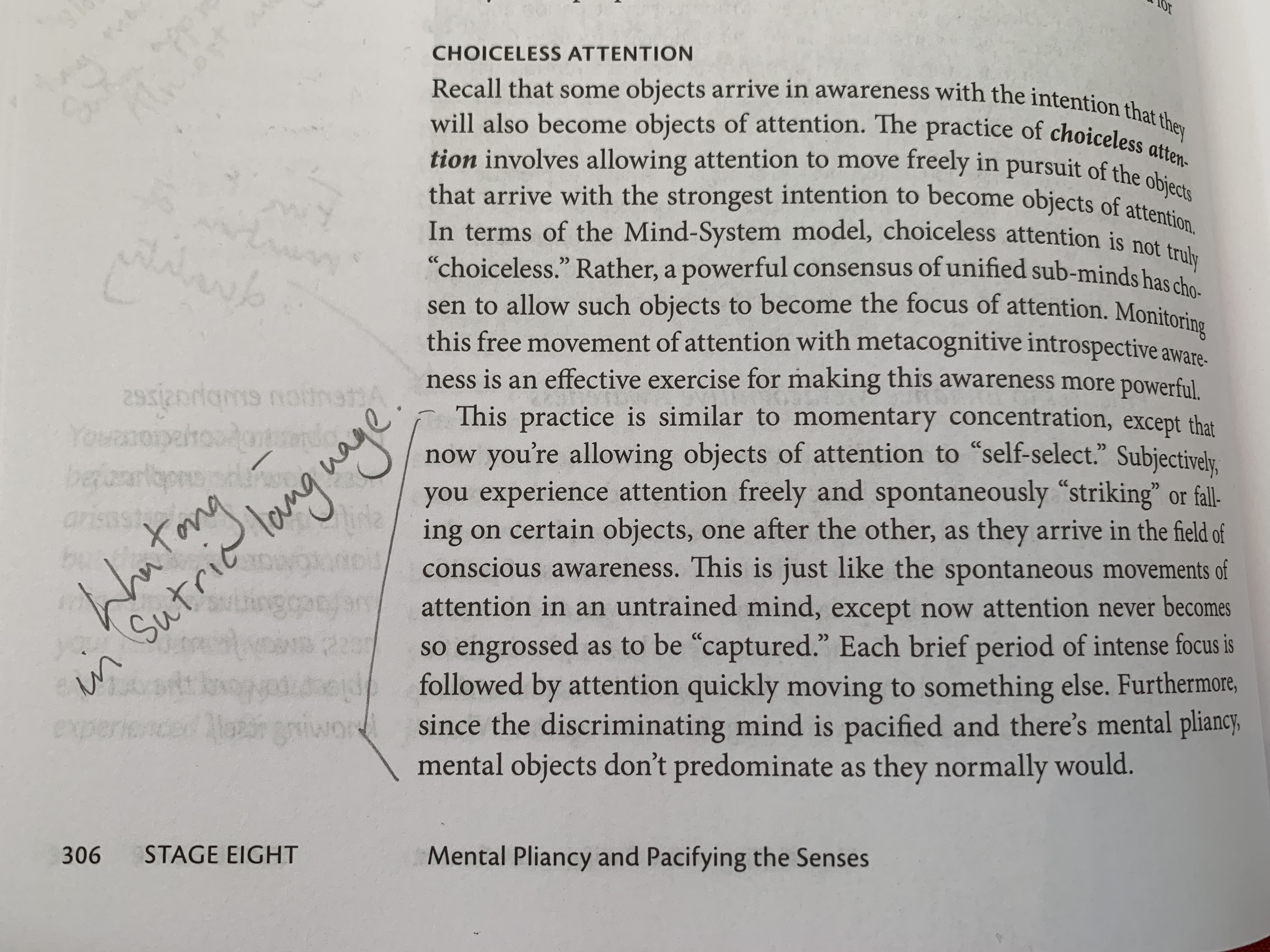
These are reflective notes on my experience of practicing Culadasa’s 10 stage meditation system. The notes in this post are from my 17th and 18th day of practice in the system. There is a page summary of my TMI series with links in the site overview. For an introduction to this project, see this page. Occasionally I will post-edit the journal. Any post-editing is [in square brackets like this].
The passage above stood out to me as interestingly different. Up until this point in The Mind Illuminated, the practice aims, in the language of this system, to “subdue the sub-minds.” Until now in the TMI system, sub-minds have been tamed of their apparent agency and subdued by a dominant awareness. Now, once they are tamed and subdued, some limited agency is returned to them and employed in service of an overarching “metacognitive introspective awareness” to increase its capacity for powerful mental control.
When I first read the passage, I was reminded of Tibetan magical tales of Padmasambhava subduing local gods to become powerful protectors of the dharma. There is a pattern: powerful all-pervading boss monster subdues local leader to become his satrap.1 It’s a well established political pattern: dominant states invade weaker ones forcing them into tributary relationships. Religions are made to justify politics: the local tradition’s folk gods are said to be lesser manifestations of the better, dominant culture’s god. This pattern repeats through Buddhist and Hindu history in both directions (Buddhist protectors are coopted into the Hindu canon and vice versa) and by both religions when dominating local cultures. It may be fitting that an effective, functional model of social control is internalized psychologically as a means to control the mind.
There is a strong strand of anarchy in the political history of Vajrayana Buddhism. It seems fitting to me that it employs a similar approach in meditation. Rather than a model of dominance and control, in shi-ne and lhatong meditations, the mind’s local occupiers – thoughts, emotions, sensations – are left alone to do whatever they would ordinarily do. As spaciousness increases, experience of the content of mind seems to change of its own accord.
Lhatong is the second meditation in the four naljors system of meditation that I practice. Lhatong means “further vision”. It leads to experiencing the content of mind without cognitive immersion. One finds presence of awareness in the movement of that which arises. The eyes are wide open, focused in space. The open posture encourages thoughts to return into the empty, concept-free space of né-pa.2 The practice is to experience thoughts and other arisings (emotion, sensation, ideation, whatever) without getting mentally caught up in it all, as one does with ordinary experience.
The passage reads to me like a description of lhatong meditation written from the perspective of Sutrayana, with dualist language. This is fitting for a system that culminates with an experience of no-self. In Vajrayana, as reflected by the four naljors meditations, the end point is experience of the nonduality of emptiness and form. Shi-ne (experience of emptiness) comes first. Lhatong (re-integration with form) logically follows shi-ne, though in practice the system is non-linear. In the Shamatha-Vipassana path of Sutrayana, the logical sequence of experience is the other way around. In Sutrayana no-self is the goal. Mental arising (form) is first subdued to that end. The experience of emptiness logically follows second to that.
Day 17
1 hour sit:
- Moving in and out of non-conceptual awareness, less sustained than usual.
- I think I was somewhat forgetting the concentrative mode and lapsing into the expansive mode, sort of neither-nor.
After this sit I decided to move into the concentrative mode from here on and explore the internal/jhana/body-focused approach. I think I am going to increase the volume of sitting per day, maybe do a mini-retreat sometime in the near future. I’d like to give the concentrative focus the opportunity to build up more and I think a few days with more intensity will help this happen.
Second sit, 30 mins:
- Internal sound again, most of this sit.
Third sit, 40 mins:
- Close following. As before - more of the same.
Day 18
1 hour sit:
- Fairly quickly went into the very, very still, calm experience characterized by the strong sense that no movement is desirable or necessary. Sat like this for most of the hour, totally still. Still aware of sounds in the environment, occasional pleasurable body sensations, like wind over my skin.
- Toward the end of the sit there was a sudden, sharp sensation in my left side throat, like a pin stabbing. Moved my attention to the sensation. It rapidly spread like a chilli pepper heat around my throat, really intense, then it exploded, like a flower bud. Tons of fluid running down my throat and my eyes were watering like hell. Simultaneously my whole body was full of pleasurable sensation, not waves, more like a light, subtle, pleasurable, shimmering.
- I let this experience be, maintaining awareness, didn’t focus on it or encourage it or mentally intervene in any way. It superseded the complete still experience. It was more like my awareness became a little more connected to my body, less ‘still and stable’ but more ‘embodied’, that is, awareness was mostly located within the physical parameters of the body, though there was still a sense of where the body was, in the space of the room.
Second sit, 1 hour:
- Nothing to report.
